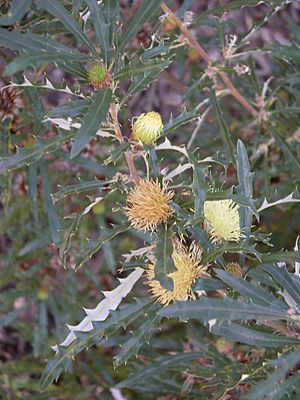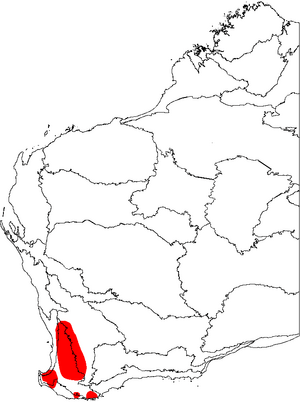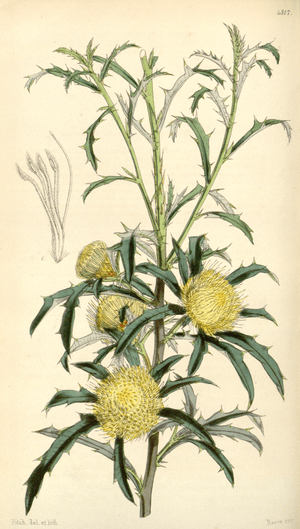Pingle facts for kids
Quick facts for kids Pingle |
|
|---|---|
 |
|
| Scientific classification | |
| Genus: |
Banksia
|
| Species: |
squarrosa
|
| Synonyms | |
|
|
The Banksia squarrosa, also known as pingle, is a type of spiky shrub. It grows only in Western Australia. This plant has long, narrow leaves with sharp teeth along the edges. It produces yellow flowers and then small, egg-shaped fruits called follicles.
Contents
What Does Pingle Look Like?
The Pingle plant is a shrub that can grow up to 4 meters (about 13 feet) tall. Unlike some other plants, it doesn't have a special woody base called a lignotuber that helps it regrow after a fire.
Leaves and Flowers
Its leaves are long and thin, measuring about 30 to 90 millimeters (1.2 to 3.5 inches) long and 5 to 12 millimeters (0.2 to 0.5 inches) wide. Each side of a leaf can have up to ten sharp, triangle-shaped teeth.
The flowers are yellow and grow in groups of about 50 to 70. At the bottom of each flower group, there are small, narrow leaf-like parts called bracts. The flowers themselves are about 18 to 24 millimeters (0.7 to 0.9 inches) long.
When Does Pingle Bloom?
Pingle plants usually bloom from June to November. After flowering, they produce small, oblong or egg-shaped fruits called follicles. These fruits are about 8 to 13 millimeters (0.3 to 0.5 inches) long and are mostly smooth. Each flower head can produce up to seven of these fruits.
How Pingle Got Its Name
The Pingle plant was first found near King George Sound in 1829 by a botanist named William Baxter. A year later, another botanist, Robert Brown, officially described it and gave it the name Dryandra squarrosa.
Changes to Its Name
Over time, scientists learned more about plants. In 1839, another plant, D. carduacea, was described. Later, in 1996, a scientist named Alex George realized that D. carduacea was actually the same plant as D. squarrosa. So, D. carduacea became a synonym, meaning it's another name for the same species.
In 1996, Alex George also identified two slightly different types, or subspecies, of D. squarrosa:
- Dryandra squarrosa subsp. argillacea: This type has slightly shorter flowers with a smooth tip.
- Dryandra squarrosa subsp. squarrosa: This type has slightly longer flowers with a hairy tip.
Then, in 2007, two scientists, Austin R. Mast and Kevin R. Thiele, moved all Dryandra plants into the Banksia group. This is why the plant is now called Banksia squarrosa. The names of its two subspecies also changed to Banksia squarrosa subsp. argillacea and Banksia squarrosa subsp. squarrosa.
Where Does Pingle Grow?
Pingle plants are found across the southwestern part of Western Australia. They grow in woodlands and forests between places like Bindoon, the Whicher Range, and Albany.
Different Subspecies Locations
The subspecies argillacea only grows in a small area near the western side of the Whicher Range. The subspecies squarrosa is found in most of the areas where Pingle grows, except for the Whicher Range area.
Pingle's Protection Status
The Western Australian Government's Department of Parks and Wildlife says that Banksia squarrosa as a whole is "not threatened." This means there are enough of these plants in the wild.
However, one of its subspecies, argillacea, is listed as "Threatened Flora (Declared Rare Flora — Extant)" by the Department of Environment and Conservation (Western Australia). This means that this particular type of Pingle is rare and needs special protection to keep it from disappearing.



